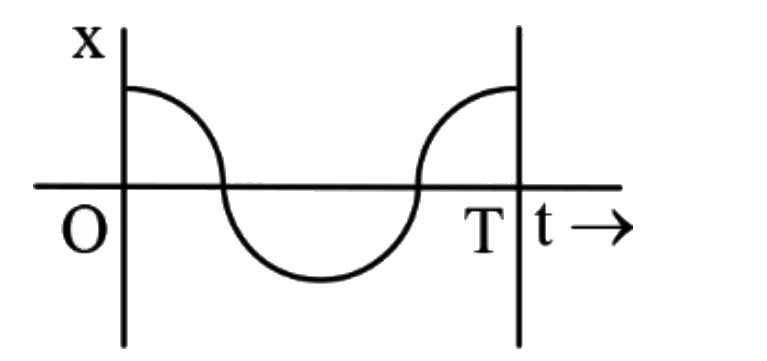A simple harmonic motino has amplitude A and time period T. The maxmum velocity will be
4AT
2AT
2π√AT
2πAT
The correct Answer is:4
To find the maximum velocity of a simple harmonic motion (SHM) with amplitude A and time period T, we can follow these steps:
1. Understand the relationship in SHM: In simple harmonic motion, the maximum velocity (Vmax) can be expressed in terms of the amplitude (A) and the angular frequency (ω).
2. Formula for maximum velocity: The formula for maximum velocity in SHM is given by:
Vmax=A⋅ω
where:
- Vmax is the maximum velocity,
- A is the amplitude,
- ω is the angular frequency.
3. Calculate angular frequency: The angular frequency (ω) is related to the time period (T) by the formula:
ω=2πT
4. Substitute ω into the maximum velocity formula: Now, substitute the expression for ω into the maximum velocity equation:
Vmax=A⋅(2πT)
5. Final expression for maximum velocity: Simplifying the equation gives us:
Vmax=2πAT
Thus, the maximum velocity of the simple harmonic motion is:
Vmax=2πAT
Conclusion:
The maximum velocity in simple harmonic motion with amplitude A and time period T is 2πAT.
---
Vmax=A⋅ω
where:
- Vmax is the maximum velocity,
- A is the amplitude,
- ω is the angular frequency.
ω=2πT
Vmax=A⋅(2πT)
Vmax=2πAT
Vmax=2πAT
The maximum velocity in simple harmonic motion with amplitude A and time period T is 2πAT.
Topper's Solved these Questions
- OSCILLATIONSBook:AAKASH INSTITUTE ENGLISHChapter:OSCILLATIONSExercise:ASSIGNMENT ( SECTION-C )
Explore 11 Videos
- OSCILLATIONSBook:AAKASH INSTITUTE ENGLISHChapter:OSCILLATIONSExercise:ASSIGNMENT (SECTION -D( Comprehension) )
Explore 3 Videos
- OSCILLATIONSBook:AAKASH INSTITUTE ENGLISHChapter:OSCILLATIONSExercise:ASSIGNMENT ( SECTION -A)
Explore 58 Videos
- NUCLEIBook:AAKASH INSTITUTE ENGLISHChapter:NUCLEIExercise:ASSIGNMENT (SECTION-D)
Explore 10 Videos
- PHYSICAL WORLDBook:AAKASH INSTITUTE ENGLISHChapter:PHYSICAL WORLDExercise:ASSIGNMENT (Section-B)
Explore 4 Videos
Similar Questions
A particle is executing simple harmonic motion with an amplitude A and time period T. The displacement of the particles after 2T period from its initial position is
View SolutionA simple harmonic motion has an amplitude A and time period T. Find the time required bu it to trvel directly form
(a) x=0 to x=A/2
(b) x=0 to x=A√2
View Solution
Knowledge Check
A particle executing simple harmonic motion with an amplitude 5 cm and a time period 0.2 s. the velocity and acceleration of the particle when the displacement is 5 cm is
A0.5πms−1,0ms−2B0.5ms−1,−5π2ms−2C0ms−1,−5π2ms−2D0.5πms−1,−0.5π2ms−2
A simple harmonic oscillation has an amplitude A and time period T. The time required to travel from x=A to x=A2 is
View SolutionA body is performing simple harmonic motion of amplitude A and time period T. The figure shown position-time graph of the body . At any time t, acceleration of the body is f, then which of the following graphs is/are appropriate?

View SolutionThree simple harmonic motions of equal amplitudes A and equal time periods in the same direction combine. The phase of the second motion is 60∘ ahead of the first and the phase of the third motion is 60∘ ahead of the second. Find the amplitude of the resultant motion.
View SolutionThree simple harmonic motion of equal amplitudes A and equal time periods in the same direction combine. The phase of the second motion is 60∘ ahead of the first and the phase of the third motion is 60∘ ahead of the second. Find the amplitude of the resultant motion.
View SolutionA simple pendulum performs simple harmonic motion about x=0 with an amplitude a ans time period T. The speed of the pendulum at x=a2 will be
View SolutionA particle starts from mean position and performs simple harmonic motion with amplitude and time period as A and T respectively. The magnitude of evrage acceleration in half time period is
View SolutionA particle executing simple harmonic motion has amplitude of 1m and time period 2s. At t=0, net force on the particle is zero. Find the equation of displacement of the particle.
View Solution